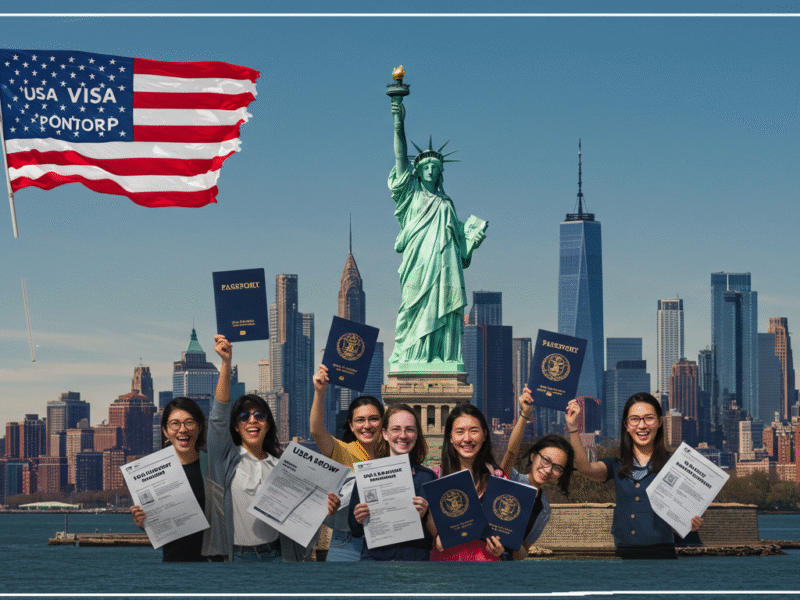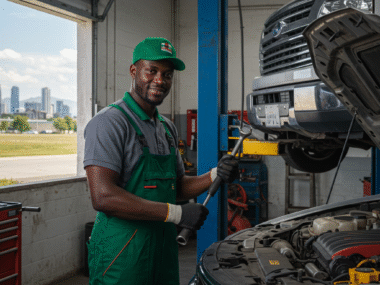Dreaming of sipping coffee in bustling New York City or hiking through the majestic Grand Canyon in 2025? With exciting USA travel opportunities backed by visa sponsorship, you can make those adventures happen sooner than you think—especially if you apply now while spots are still available.
Let’s face it, traveling to the United States has always been a bucket-list item for millions around the world. The country offers everything from iconic landmarks like the Statue of Liberty to hidden gems in national parks, vibrant cultural festivals, and world-class job markets. But getting there often requires more than just a plane ticket; for many, it involves securing a visa with sponsorship. In 2025, visa sponsorship programs are evolving with new updates, making it easier for skilled professionals, students, and even families to enter the USA legally and start their journeys. Whether you’re eyeing a work visa to build your career or a study visa to immerse yourself in American education, this guide will walk you through everything you need to know about USA travel with visa sponsorship in 2025. I’ll keep things straightforward, like we’re chatting over coffee, so you can focus on planning your trip without the headache.
Understanding Visa Sponsorship
What is Visa Sponsorship?
First off, what exactly is visa sponsorship? It’s basically when a U.S. employer, university, or family member agrees to support your visa application. This sponsorship acts as a guarantee to the U.S. government that you’ll have a legitimate reason to be in the country, like working, studying, or reuniting with loved ones. Without it, many non-immigrant and immigrant visas are out of reach. In 2025, with the economy rebounding and industries like tech, healthcare, and tourism booming, sponsors are actively seeking international talent. This means more chances for you to travel to the USA with visa sponsorship, but competition is fierce, so applying early is key.
Why 2025 is the Year to Act
Why focus on 2025? Well, the U.S. immigration system is constantly updating. For instance, the H-1B visa cap for fiscal year 2025 has already seen changes in the lottery process to make it fairer, and there’s talk of increased quotas for certain sectors. If you’re from countries like India, China, or the Philippines, where backlogs are common, staying informed about these shifts can give you an edge. Plus, with remote work trends fading and in-person roles surging, companies are sponsoring visas to fill gaps in fields like IT, engineering, and nursing. Imagine landing a job in Silicon Valley or Miami—your travel dreams could double as career boosters.
Types of Visa Sponsorship
Work-Related Visas
Now, let’s dive into the types of visas that commonly involve sponsorship. The most popular for work-related travel is the H-1B visa. This is for specialty occupations requiring at least a bachelor’s degree or equivalent experience. In 2025, the H-1B lottery registration typically opens in March, with selections announced by April. If your employer sponsors you, you could be working (and traveling) in the USA by October 2025. High-demand jobs include software developers, data analysts, and financial advisors—roles with salaries often exceeding $80,000 annually, which helps cover your travel costs and more.
Another option is the L-1 visa for intracompany transfers. If you work for a multinational company outside the USA, your employer can sponsor you to transfer to a U.S. branch. This is perfect for managers or specialized knowledge workers. In 2025, processing times are expected to be around 3-6 months, depending on premium processing fees. It’s a great way to travel for business while exploring cities like Chicago or Los Angeles on weekends.
Student and Exchange Visas
For students dreaming of USA travel with visa sponsorship, the F-1 visa is a top choice. Universities sponsor international students, allowing you to study full-time and even work on-campus. With over 4,000 accredited institutions, options range from Ivy League schools to community colleges. In 2025, expect more scholarships tied to sponsorships, especially in STEM fields. Once approved, you can travel during breaks to places like Yellowstone National Park or the beaches of Florida.
Don’t overlook the J-1 visa for exchange visitors. This covers interns, trainees, au pairs, and researchers. Sponsors like cultural exchange programs or companies provide the backing, and it’s ideal for short-term travel—up to 18 months in some cases. In 2025, programs in hospitality and agriculture are expanding, offering sponsored spots in tourist hotspots like Hawaii or Colorado.
Family-Based and Employment-Based Immigrant Visas
Family-based sponsorships are huge for immigrant visas. If you have a U.S. citizen or permanent resident relative, they can petition for you via forms like I-130. This leads to green cards, enabling permanent USA travel. Processing in 2025 might take 12-24 months, but it’s worth it for reuniting and exploring together.
Employment-based green cards, like EB-1 for extraordinary ability or EB-2 for advanced degrees, also involve sponsorship. Employers file petitions, and with labor shortages in 2025, sectors like renewable energy and biotech are hot. Once you have your green card, travel within the USA is unrestricted, from road trips along Route 66 to ski trips in Aspen.
Finding a Visa Sponsor
Job Search Strategies
How do you find a sponsor? Start by networking on platforms like LinkedIn. Search for “USA visa sponsorship jobs 2025” and connect with recruiters. Websites like Indeed or Glassdoor often list sponsored positions—keywords like “H1B sponsor” or “visa sponsorship available” are your friends. Attend virtual job fairs focused on international hires; many are scheduled for early 2025.
Student and Family Sponsorship
For students, use university websites or agents certified by the U.S. Department of State. Look for programs offering “visa sponsorship for international students 2025.” Family sponsorship? Consult immigration lawyers to ensure your relative qualifies.
Visa Application Process
Steps to Apply
The application process starts with your sponsor filing a petition with USCIS (U.S. Citizenship and Immigration Services). For H-1B, it’s Form I-129. Once approved, you apply for the visa at a U.S. embassy or consulate in your home country. You’ll need a DS-160 form, passport, photos, and proof of ties to your home country to show you won’t overstay.
Required Documents
Documents are crucial: resume, diplomas, job offer letters, and financial statements. In 2025, digital submissions are more common, speeding things up. Biometrics and interviews follow—be honest and prepared. Fees range from $460 for the visa application to $2,805 for premium processing.
Challenges and Solutions
Challenges? Backlogs and lotteries can be frustrating. For H-1B 2025, only about 85,000 spots are available annually, with millions applying. Solution: Apply to multiple sponsors and consider alternatives like O-1 visas for artists or athletes.
Tips for Success
Building a Strong Profile
Success tips: Build a strong profile. Learn English if needed, gain certifications, and tailor your resume to U.S. standards. Research sponsors who have a history of approvals—tools like myvisajobs.com can help.
Travel Planning in the USA
Once in the USA, travel smart. Use apps like Google Maps for navigation, and budget for domestic flights via airlines like Southwest. Visit national parks with an America the Beautiful pass for $80 annually. Cities like San Francisco offer sponsored tech jobs and proximity to Yosemite.
Industry-Specific Opportunities in 2025
Healthcare
In healthcare, nursing shortages mean more RN visa sponsorships in 2025. Hospitals in Texas or California sponsor via EB-3 visas, leading to green cards. Imagine working in sunny San Diego while weekend-tripping to Mexico’s border towns.
Technology
Tech enthusiasts: Silicon Valley giants like Google and Apple sponsor H-1Bs. With AI booming in 2025, roles in machine learning pay over $150,000, funding travels to Lake Tahoe or Vegas.
Education and Research
For educators, J-1 teacher exchanges sponsor stays in states like New York, where you can explore museums and Broadway.
Agriculture and Hospitality
Agriculture: Seasonal H-2A visas for farm work in 2025, sponsored by U.S. farmers. Travel to rural beauties like the Midwest prairies.
Hospitality: H-2B for non-agricultural temp work, like resorts in Florida. Sponsored spots in Disney World areas let you work and play.
Creative and Business Fields
Creative fields: O-1 for filmmakers or musicians. Sponsors include Hollywood studios, enabling LA travels.
Entrepreneurs: E-2 investor visas if you invest in a U.S. business. In 2025, tech startups are prime.
Other Industries
Family reunions: Sponsored by spouses or parents, leading to explorations of family hometowns.
Study abroad: F-1 sponsors at universities like Harvard offer campus life plus travels to Boston’s historic sites.
Research: J-1 for scholars at labs in Boston or Seattle.
Au pairs: Live with families in suburbs, traveling to nearby cities on days off.
Internships: Summer programs in finance, sponsored by Wall Street firms.
Volunteering: Some J-1s cover eco-projects in national parks.
Business: L-1 for execs, with travels to conferences in Vegas.
Sports: P-1 for athletes, sponsored by teams.
Artists: O-1 for gallery shows in NYC.
Medical: J-1 for residencies in hospitals.
Engineering: H-1B in aerospace, like NASA affiliates in Florida.
Finance: Wall Street sponsorships.
Marketing: Digital agencies in Austin.
Legal: Paralegal roles with sponsorship.
Real estate: Investment-based E-2s.
Environmental: Green jobs in California.
Renewable energy: Wind farms in Texas.
Biotech: Labs in Boston.
Pharma: Companies in New Jersey.
Automotive: EV firms in Michigan.
Aerospace: Boeing in Washington.
Defense: Contractors in Virginia.
Education tech: Startups in San Francisco.
E-commerce: Amazon warehouses, but more for skilled roles.
Logistics: Supply chain in Atlanta.
Tourism: Hotel chains in Orlando.
Food industry: Chefs with O-1.
Fashion: Designers in NYC.
Media: Journalists with I visas, but sponsored options exist.
Entertainment: Actors with O-1.
Music: Tours sponsored by labels.
Gaming: Developers in LA.
Esports: Teams sponsoring players.
Fitness: Trainers with business sponsorships.
Wellness: Yoga instructors via O-1.
Beauty: Salons investing in E-2.
Retail: Management transfers.
Wholesale: Import/export firms.
Construction: Engineers sponsored.
Architecture: Firms in Chicago.
Interior design: High-end sponsors.
Photography: Media companies.
Writing: Content creators with O-1.
Blogging: If tied to business.
Vlogging: Sponsored channels.
Social media: Influencers with extraordinary ability.
Podcasting: Media sponsorships.
Detailed Visa Insights
H-1B Visa
Starting with H-1B in detail: The cap is 65,000 plus 20,000 for master’s degrees. 2025 lottery is random, but beneficiaries with multiple registrations get one chance. Employers pay fees, you handle visa stamping. Jobs must pay prevailing wages. Extensions possible up to 6 years, then green card path.
L-1 Visa
For L-1A (managers), blanket petitions speed things. L-1B for knowledge workers. Premium processing: 15 days for $2,805.
F-1 Visa
F-1: SEVIS fee $350, I-20 form from school. OPT post-graduation for work experience.
J-1 Visa
J-1: DS-2019 from sponsor. Two-year home residency rule for some.
Employment-Based Green Cards
EB-1: No labor cert needed, for geniuses.
EB-2: PERM labor cert, then I-140.
EB-3: For skilled workers, longer waits.
Practical Steps for Applicants
Job Search and Networking
Finding jobs: Use visa-sponsoring job boards. Network at conferences. Update LinkedIn with “open to USA visa sponsorship 2025.”
Application Timeline
Application timeline: Research (now), apply to jobs (fall 2024 for 2025 starts), petition (Jan-Mar), visa (Apr-Sep).
Documentation
Documents: Passports valid 6 months beyond stay, photos 2×2 inches, fee receipts, sponsor letters, educational creds, work experience letters, financial proof for non-workers.
Interviews and Denials
Interviews: At consulates, questions on intent, job, ties home. Dress professionally, bring all docs.
Denials: Common for incomplete apps or fraud suspicions. Appeal or reapply.
Costs and Benefits
Costs: H-1B petition $460-$2,500, visa $205, lawyer $3,000+.
Benefits: Legal work, family accompaniment (H-4), path to citizenship, travel freedoms.
Travel Tips for 2025
Transportation and Budgeting
Travel tips: Amtrak for trains, Greyhound buses, Uber for cities. Budget $100/day for food/lodging. Must-see: Niagara Falls, Yellowstone, Vegas Strip, DC monuments, Hawaii beaches, Alaska glaciers, Route 66 drives.
Seasonal and Cultural Experiences
Seasonal: Spring cherry blossoms in DC, summer beaches, fall foliage in New England, winter skiing in Rockies.
Cultural: Festivals like Coachella, Mardi Gras, Thanksgiving parades.
Food, Shopping, and Activities
Food: Try burgers in Texas, seafood in Maine, tacos in California.
Shopping: Outlets in Orlando, malls in Minneapolis.
Adventure: Skydiving in Arizona, surfing in Hawaii.
Relaxation: Spas in Sedona, wineries in Napa.
History: Boston Freedom Trail, Philadelphia bells.
Nature: Everglades, Great Smoky Mountains.
Urban: NYC subways, LA Hollywood.
Success Stories and Challenges
Inspiring Examples
Success stories: Think of someone from India landing Google H-1B, traveling coast-to-coast. Or a nurse from Philippines in NYC, visiting family nationwide.
Potential Challenges
Challenges 2025: Potential policy changes under new admin, but sponsorships remain strong for economy.
Staying Informed
Stay updated via USCIS alerts.
Conclusion
In conclusion, USA travel with visa sponsorship in 2025 is your gateway to incredible experiences. Apply now to secure your spot—don’t wait!
For more details, check the official USCIS website or explore job opportunities on Indeed.











